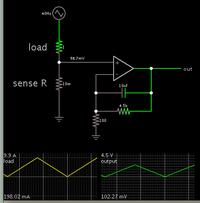T
treez
Guest
Hello,
I am using the following differential amplifier to measure current in the sense resistor.
I dont need great accuracy, but just need to know if its 1A, 2A, 3A, ...10A
schematic:
https://i45.tinypic.com/72tvsi.jpg
(the opamp used will be OPA335 .....-> https://www.ti.com/lit/ds/symlink/opa335.pdf )
....when the current is 1A, the output of the opamp will be just 100* 1mV = 100mV.
...unfortunately, page 3 of the OPA335 datasheet says that the VOL of the OPA335 is 100mV.....so does this mean that i wont be able to measure this 1A current?
Also, regarding the VOL value on page 3 of the OPA335 opamp datasheet, i dont understand how VOL is lower when the load is 100K, compared to when its 10K.......i would have thought that the 10K load would make the VOL lower than when there was a 100K load?
I am using the following differential amplifier to measure current in the sense resistor.
I dont need great accuracy, but just need to know if its 1A, 2A, 3A, ...10A
schematic:
https://i45.tinypic.com/72tvsi.jpg
(the opamp used will be OPA335 .....-> https://www.ti.com/lit/ds/symlink/opa335.pdf )
....when the current is 1A, the output of the opamp will be just 100* 1mV = 100mV.
...unfortunately, page 3 of the OPA335 datasheet says that the VOL of the OPA335 is 100mV.....so does this mean that i wont be able to measure this 1A current?
Also, regarding the VOL value on page 3 of the OPA335 opamp datasheet, i dont understand how VOL is lower when the load is 100K, compared to when its 10K.......i would have thought that the 10K load would make the VOL lower than when there was a 100K load?
